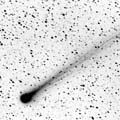
|
It reached to 5.2 mag at best in late February and early March. Now it is fading gradually. But the fading is slow so far, and it is bright as 7.6 mag still now (Mar. 31, Seiichi Yoshida). Moderately condensed. In the Northern Hemisphere, it keeps observable in good condition until it fades out. It will be fading gradually in the morning sky after this. It will be visible visually until June.
Date(TT) R.A. (2000) Decl. Delta r Elong. m1 Best Time(A, h)
Apr. 1 22 31.21 49 8.8 1.197 0.988 52 7.8 4:22 (229, 30)
Apr. 8 23 3.92 54 3.3 1.358 1.102 53 8.6 4:11 (222, 29)
|
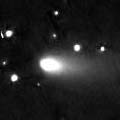
|
It is already very bright and visible visually, 9.6 mag on Mar. 31 (Seiichi Yoshida). Very strongly condensed. The stellar false nucleus and the broad tail are clearly visible visually. It has been brightening rapidly well, but the brightening evolution is slightly slower than originally expected. It will pass only 0.08 A.U. from the earth on May 12, remarkable approach after 76 years since its discovery in 1930. It will be 4 mag at best, and will be visible with naked eyes. It keeps observable in good condition all through the encounter in May, while it will be brightening rapidly. Now two other components B and G are also bright. Due to the approach of the comet, Bootids meteor shower observed in 1930 may appear in outburst again in May and June. But the earth will not pass through the dust trail in calculation.
Date(TT) R.A. (2000) Decl. Delta r Elong. m1 Best Time(A, h)
Apr. 1 14 40.69 19 35.3 0.390 1.328 141 9.7 2:04 ( 0, 74)
Apr. 8 14 53.66 21 48.5 0.320 1.265 140 8.9 1:50 ( 0, 77)
|
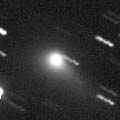
|
It has been visible visually in the southern low sky since last August. It has been bright as 10 mag for three months since December. It was very small and sharp before, however, now it looks like a typical diffuse comet. The altitude is getting lower slowly in the evening sky, and it will be too low to observe in April. It will appear in the morning sky again in late August at 13.5 mag. It will come to locate high in October, then it will be visible visually again at 14 mag.
Date(TT) R.A. (2000) Decl. Delta r Elong. m1 Best Time(A, h)
Apr. 1 2 3.20 23 22.2 2.420 1.602 27 10.4 19:46 (112, 9)
Apr. 8 2 25.97 25 34.9 2.468 1.635 26 10.5 19:53 (116, 8)
|
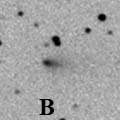
|
It had been brightening well as expected until late March. It was 11.9 mag on Mar. 31 (Seiichi Yoshida). However, an unexpected outburst happened on Apr. 2. Now it is so bright as around 9.5 mag, as bright as the component C. Although it was moderately condensed until late March, now it is very strongly condensed and the stellar false nucleus is clearly visible because shortly after the outburst. It will pass only 0.067 A.U. from the earth on May 14, remarkable approach after 76 years since its discovery in 1930. It keeps observable in good condition all through the encounter in May while brightening rapidly. If it keeps the current brightness, it will reach to 4 mag, as bright as the component C, and become a naked eye object, too. However, the future brightness change is uncertain.
Date(TT) R.A. (2000) Decl. Delta r Elong. m1 Best Time(A, h)
Apr. 1 14 30.55 20 34.5 0.395 1.337 143 11.8 1:54 ( 0, 75)
Apr. 8 14 40.70 22 57.0 0.326 1.274 142 11.0 1:37 ( 0, 78)
|

|
It had been originally expected to reach to 9 mag at best. But the brightness evolution has been very slow, and it is much fainter than expected actually. It was expected to be observable at 10 mag in the Southern Hemisphere in last autumn, however, it was only 12-13 mag actually. Then, it had been too low even in the Southern Hemisphere from January to February, and only few observations were reported. However, it is getting observable finally in the morning sky also in the Northern Hemisphere. It will be observable in good condition after this until autumn. It was 12.6 mag on Mar. 30 (Katsumi Yoshimoto). It will be visible bright as 12 mag for a while.
Date(TT) R.A. (2000) Decl. Delta r Elong. m1 Best Time(A, h)
Apr. 1 20 23.48 -17 54.8 1.875 1.749 67 11.9 4:22 (309, 18)
Apr. 8 20 17.54 -14 23.3 1.770 1.789 74 11.9 4:11 (310, 24)
|
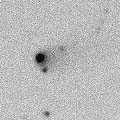
|
It brightened faster than a typical comet, and became visible visually as 13.5 mag in October (Oct. 24, Seiichi Yoshida). Now it is still bright as 13.4 mag (Feb. 27, Seiichi Yoshida). Small and strongly condensed. Because it is distant from the sun, it keeps observable at 13.5 mag in good condition for a long time until 2006 June.
Date(TT) R.A. (2000) Decl. Delta r Elong. m1 Best Time(A, h)
Apr. 1 9 38.49 51 16.5 4.731 5.192 112 13.6 21:00 (180, 74)
Apr. 8 9 38.42 50 34.2 4.808 5.191 107 13.6 20:32 (180, 75)
|
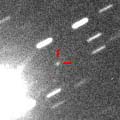
|
It has been brightening up to 15.2 mag on Mar. 14 (Ken-ichi Kadota). It is getting brighter rapidly in the morning sky. It was fainter than 13.0 mag and not visible visually on Mar. 31 (Seiichi Yoshida). But it will become visible visually soon. It will reach to 12 mag in June. The condition is best beucase it is almost at opposition at the perihelion passage. However, it will be very low, only 13-20 deg high, from June to September in the Northern Hemisphere. When it gets higher again, it will be fainter than 14 mag, too faint to see visually.
Date(TT) R.A. (2000) Decl. Delta r Elong. m1 Best Time(A, h)
Apr. 1 17 33.56 -20 40.1 1.097 1.689 107 13.9 4:22 (350, 34)
Apr. 8 17 48.64 -21 37.9 1.024 1.665 110 13.6 4:11 (351, 33)
|

|
In 2005, outbursts occured in September and November, when it brightened up to 12.5-13 mag. It had been faint as around 15 mag in December and January. However, it has been bright at around 13 mag since late January. It was still bright as 13.2 mag on Mar. 18 (Rolando Ligustri). But it will be too low to observe soon.
Date(TT) R.A. (2000) Decl. Delta r Elong. m1 Best Time(A, h)
Apr. 1 2 28.94 23 20.3 6.618 5.798 32 13.8 19:46 (109, 14)
Apr. 8 2 34.58 23 41.6 6.674 5.800 26 13.8 19:53 (113, 9)
|
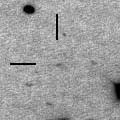
|
It has been brightening well, 15.6 mag on Mar. 23 (E. J. Christensen). It keeps observable in good condition all through the encounter in May while brightening rapidly. It was fainter than 13.7 mag and not visible visually on Mar. 31 (Seiichi Yoshida). But it will become visible visually in early April, and reach to 8.5 mag at best in May. However, the future brightness evolution is uncertain because this is a small component.
Date(TT) R.A. (2000) Decl. Delta r Elong. m1 Best Time(A, h)
Apr. 1 14 28.83 20 44.4 0.396 1.339 143 15.3 1:53 ( 0, 76)
Apr. 8 14 38.50 23 8.2 0.327 1.276 142 14.6 1:35 ( 0, 78)
|
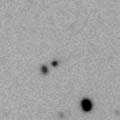
|
It was so faint as 18.5 mag at the discovery in early December, but it brightened up to 17 mag in mid January. Then it started brightening extremely rapidly after mid January. It was visible visually as bright as 14.0 mag in late February (Feb. 27, Seiichi Yoshida). Very strongly condensed and almost stellar. It will be observable in good condition, however, it will fade out soon after April.
Date(TT) R.A. (2000) Decl. Delta r Elong. m1 Best Time(A, h)
Apr. 1 10 31.68 25 50.6 0.935 1.797 136 15.5 21:53 ( 0, 81)
Apr. 8 10 38.12 26 21.6 0.988 1.809 130 15.9 21:32 ( 0, 81)
|
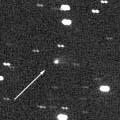
|
It will pass the perihelion soon, in 2006 February. But it did not brightened so much as expected, 15.7 mag on Dec. 18 (Ken-ichi Kadota). It keeps observable at 15-16 mag for a long time from 2005 spring to the end of 2006. Because it moves in the northern sky, it keeps observable for a long time in the Northern Hemisphere. It is brightest until May, but keeps lower than 30 deg high.
Date(TT) R.A. (2000) Decl. Delta r Elong. m1 Best Time(A, h)
Apr. 1 22 56.70 53 49.0 3.712 3.224 53 15.7 4:22 (222, 28)
Apr. 8 23 12.31 53 47.1 3.749 3.232 52 15.7 4:11 (222, 28)
|
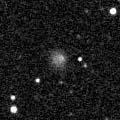
|
It had been an extremely faint Centaur asteroid until 2004, fainter than 21 mag. However, it brightened up to 17.5 mag on 2005 Dec. 30, and a coma was observed, then it was revealed to be a comet. It brightened furthermore, 14.8 mag on Jan. 7 (Ken-ichi Kadota). It was also visible visually at 14.4 mag (Jan. 8, Seiichi Yoshida). It looked like a planetary nebula. It was diffuse visually. It seems to be a temporary brightening in outburst. It will return to be so faint as 21 mag in the near future. However, it still keeps bright as 15.7 mag on Apr. 2 (Giovanni Sostero and Ernesto Guido). It will pass the perihelion in 2015. The heliocentric distance reduces down to 5.9 A.U., but it will be 17 mag at best. However, another outburst may happen again in the future.
Date(TT) R.A. (2000) Decl. Delta r Elong. m1 Best Time(A, h)
Apr. 1 13 9.93 -5 19.8 11.918 12.910 172 15.7 0:34 ( 0, 50)
Apr. 8 13 8.29 -5 9.0 11.897 12.897 178 15.8 0:05 ( 0, 50)
|
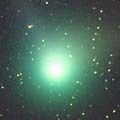
|
It was fantastic, so bright as 3.5 mag, so large as 30 arcmin, locating high overhead at its best time in early 2004 January. Then it has been getting fainter gradually, and become already too faint to see visually. However, it is still bright as 15.6 mag by CCD observations (Mar. 4, Katsumi Yoshimoto). It keeps observable until October when it becomes fainter than 18 mag.
Date(TT) R.A. (2000) Decl. Delta r Elong. m1 Best Time(A, h)
Apr. 1 16 59.08 2 4.2 4.829 5.331 115 15.7 4:22 (359, 57)
Apr. 8 16 57.12 2 22.0 4.803 5.395 121 15.7 3:53 ( 0, 57)
|
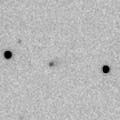
|
It brightened faster than a typical comet, and it reached to 15.8 mag on Feb. 9 (Ken-ichi Kadota). It will be observable in good condition as 16 mag for a long time until next spring. It was too faint to see visually, fainter than 13.9 mag (Mar. 31, Seiichi Yoshida).
Date(TT) R.A. (2000) Decl. Delta r Elong. m1 Best Time(A, h)
Apr. 1 10 17.67 65 17.2 4.626 4.989 105 16.1 21:39 (180, 60)
Apr. 8 10 16.42 64 30.2 4.691 4.993 101 16.1 21:10 (180, 61)
|
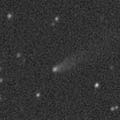
|
Although it was faint as 18 mag at the discovery in 2004 November, then it brightened very rapidly until early 2005, and reached to 16.0 mag on May 7 (Ken-ichi Kadota). After it appeared in the morning sky again, it continued brightening furthermore, and reached to 14.7 mag on Nov. 22 (Ken-ichi Kadota). It is also visible visually as 14.0 mag (Feb. 27, Seiichi Yoshida). In the Northern Hemisphere, it keeps observable in good condition until summer when it becomes too faint.
Date(TT) R.A. (2000) Decl. Delta r Elong. m1 Best Time(A, h)
Apr. 1 13 52.57 15 11.0 1.945 2.874 153 16.1 1:17 ( 0, 70)
Apr. 8 13 46.95 15 15.0 1.962 2.903 155 16.2 0:44 ( 0, 70)
|
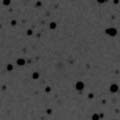
|
Great outburst over 6 mag has occured always in recent appearances in 1995 and 2001. The ephemeris says it will be 14 mag at best, but the actual brightness evolution will not be along the prediction. It is expected to be visible visually due to an unpredicted outburst again in this return. It is 16.6 mag on Mar. 3 (Toni Scarmato), already brighter than this ephemeris. Although it will not approach to the earth so much in this return, it keeps observable all through the period in the evening sky until autumn. It becomes brightest in June and too faint in autumn. It keeps locating around 30 degree high after May.
Date(TT) R.A. (2000) Decl. Delta r Elong. m1 Best Time(A, h)
Apr. 1 6 0.77 22 10.4 1.195 1.406 79 16.5 19:46 ( 77, 56)
Apr. 8 6 14.56 23 2.9 1.193 1.351 75 16.2 19:53 ( 83, 53)
|
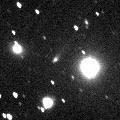
|
It had been observed at 16 mag by CCD, or 14 mag visually, in spring and summer in 2005. Now it is appearing again in the morning sky. It will be observable again at 16 mag in spring and summer in 2006. But the altitude will be somewhat lower than in 2005.
Date(TT) R.A. (2000) Decl. Delta r Elong. m1 Best Time(A, h)
Apr. 1 19 42.20 -2 5.7 4.013 3.873 74 16.4 4:22 (305, 37)
Apr. 8 19 44.68 -2 39.1 3.925 3.892 80 16.4 4:11 (309, 39)
|
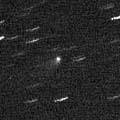
|
It was visible visually as 14.3 mag in 2005 spring (July 10, Edwin van Dijk). Now it is 16.6 mag (Feb. 5, Ken-ichi Kadota). Although it keeps 16.5 mag from December to early April, then it will fade out rapidly, and become fainter than 18 mag in July.
Date(TT) R.A. (2000) Decl. Delta r Elong. m1 Best Time(A, h)
Apr. 1 11 49.19 19 22.5 3.284 4.200 153 16.6 23:09 ( 0, 74)
Apr. 8 11 36.30 19 50.8 3.375 4.236 145 16.7 22:28 ( 0, 75)
|
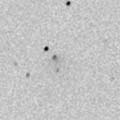
|
It passes the perihelion in 2006 February. But it is outside of Jupiter's orbit. So it keeps 17 mag for a long time. Because it moves in the northern sky, it keeps locating high and observable in good condition until 2006 summer.
Date(TT) R.A. (2000) Decl. Delta r Elong. m1 Best Time(A, h)
Apr. 1 14 50.96 69 51.4 6.518 6.806 102 16.7 2:15 (180, 55)
Apr. 8 14 39.95 69 50.8 6.538 6.808 101 16.7 1:37 (180, 55)
|
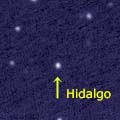
|
It reached to 13 mag and was observed visually in good condition in 2004 autumn. It has been not observable since August, but it is appearing at dawn again. It keeps 17 mag until late April. But it will go away soon after that. Next return is in 2018, when it will be 14.3 mag at best.
Date(TT) R.A. (2000) Decl. Delta r Elong. m1 Best Time(A, h)
Apr. 1 13 1.33 6 29.5 3.191 4.173 167 16.7 0:26 ( 0, 61)
Apr. 8 12 54.93 6 26.7 3.235 4.215 166 16.8 23:47 ( 0, 61)
|

|
In addition to the bright three components, C, B and G, many other faint components have been discovered. They seem to have been separated from the component B. Now two of them, R and N, are brightening rapidly. The component R is 16.9 mag, and N is 17.8 mag. The other components are extremely faint. They are tiny fragments and the brightness change is very uncertain. The components H and L have already started fading.
Date(TT) R.A. (2000) Decl. Delta r Elong. m1 Best Time(A, h)
Apr. 1 14 27.02 20 54.6 0.397 1.340 143 17.8 1:51 ( 0, 76)
Apr. 8 14 36.20 23 19.8 0.328 1.277 142 17.0 1:32 ( 0, 78)
|

|
Although it is not observable around the perihelion passage, it is observable at 17-17.5 mag in good condition both in spring and autumn.
Date(TT) R.A. (2000) Decl. Delta r Elong. m1 Best Time(A, h)
Apr. 1 8 54.00 65 45.2 1.716 2.116 98 17.4 20:12 (180, 59)
Apr. 8 8 5.74 63 4.4 1.804 2.069 90 17.4 19:53 (167, 61)
|
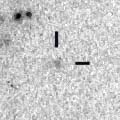
|
It is observable at 17.7 mag in 2006 spring. It is also observable at 17.5 mag in 2007 spring, but the altitude will be a bit lower.
Date(TT) R.A. (2000) Decl. Delta r Elong. m1 Best Time(A, h)
Apr. 1 11 13.36 8 33.3 3.919 4.841 154 17.7 22:34 ( 0, 64)
Apr. 8 11 10.65 8 44.3 3.963 4.835 147 17.8 22:04 ( 0, 64)
|
|
![]()
 C/2006 CK10 ( Catalina )
C/2006 CK10 ( Catalina ) 99P/Kowal 1
99P/Kowal 1![]()




















